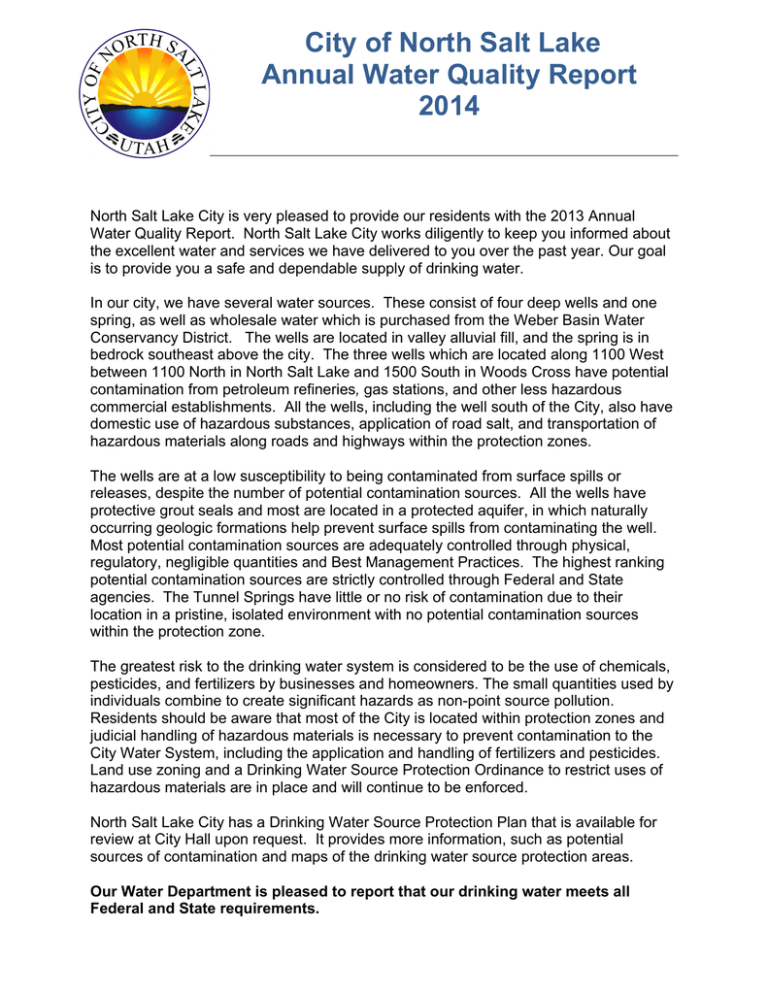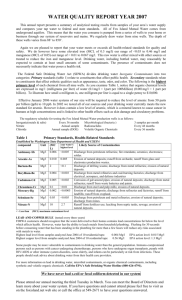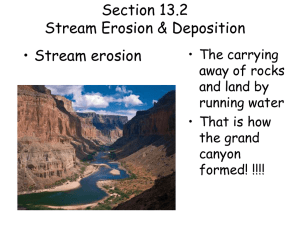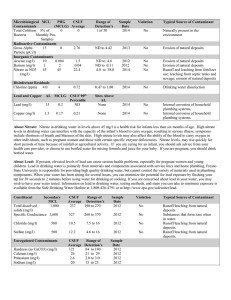North Salt Lake City
advertisement

City of North Salt Lake Annual Water Quality Report 2014 North Salt Lake City is very pleased to provide our residents with the 2013 Annual Water Quality Report. North Salt Lake City works diligently to keep you informed about the excellent water and services we have delivered to you over the past year. Our goal is to provide you a safe and dependable supply of drinking water. In our city, we have several water sources. These consist of four deep wells and one spring, as well as wholesale water which is purchased from the Weber Basin Water Conservancy District. The wells are located in valley alluvial fill, and the spring is in bedrock southeast above the city. The three wells which are located along 1100 West between 1100 North in North Salt Lake and 1500 South in Woods Cross have potential contamination from petroleum refineries, gas stations, and other less hazardous commercial establishments. All the wells, including the well south of the City, also have domestic use of hazardous substances, application of road salt, and transportation of hazardous materials along roads and highways within the protection zones. The wells are at a low susceptibility to being contaminated from surface spills or releases, despite the number of potential contamination sources. All the wells have protective grout seals and most are located in a protected aquifer, in which naturally occurring geologic formations help prevent surface spills from contaminating the well. Most potential contamination sources are adequately controlled through physical, regulatory, negligible quantities and Best Management Practices. The highest ranking potential contamination sources are strictly controlled through Federal and State agencies. The Tunnel Springs have little or no risk of contamination due to their location in a pristine, isolated environment with no potential contamination sources within the protection zone. The greatest risk to the drinking water system is considered to be the use of chemicals, pesticides, and fertilizers by businesses and homeowners. The small quantities used by individuals combine to create significant hazards as non-point source pollution. Residents should be aware that most of the City is located within protection zones and judicial handling of hazardous materials is necessary to prevent contamination to the City Water System, including the application and handling of fertilizers and pesticides. Land use zoning and a Drinking Water Source Protection Ordinance to restrict uses of hazardous materials are in place and will continue to be enforced. North Salt Lake City has a Drinking Water Source Protection Plan that is available for review at City Hall upon request. It provides more information, such as potential sources of contamination and maps of the drinking water source protection areas. Our Water Department is pleased to report that our drinking water meets all Federal and State requirements. If you have any questions or concerns about this report or your water utility, please contact Jonathan Rueckert at (801)-335-8727, or at 10 East Center Street, North Salt Lake City, Utah 84054. We want our valued customers and residents to be informed about their water utility. If you want to learn more, please attend any of our regularly scheduled meetings. They are held on the first and third Tuesdays of the month, 7:00 p.m., at the North Salt Lake City Hall, 10 East Center Street, North Salt Lake City, Utah. North Salt Lake City routinely monitors for constituents in our drinking water in accordance with the Federal and Utah State laws. The following table shows the results of our monitoring for the period of January 1st , 2014 to December 31st, 2014. In our continuing efforts to maintain a safe and dependable water supply, it may be necessary to make improvements and/or changes in your water system. The costs of these improvements may be reflected in the rate structure. Rate adjustments may be necessary in order to address these improvements. In addition, it is the responsibility of the home owner to have each BACKFLOW ASSEMBLY and/or device on their landscaping system tested and/or repaired every year to meet all Federal, State and Local ordinances and laws. When a backflow device fails, it can seriously affect the quality and safety of our drinking water supply. What is Back flow? Back flow is the reverse flow of contaminated water or other substances from a user's water system back into the public drinking water system. Backflow can occur if your plumbing system is physically connected (a cross connection) to any source of contamination or pollution. Common examples of possible cross connections include landscape sprinkling systems, hose attachments for utility sinks, and garden hoses. Backflow prevention assemblies provide the public water supply system with protection against contamination or pollution. All results should be sent to the North Salt Lake City Water Department at 10 East Center Street, North Salt Lake, Utah 84054 by August 15, 2015. If you have any questions or concerns please call 801-335-8727 or view our backflow pamphlet on our website at www.nslcity.org. Some people may be more vulnerable to contaminants in drinking water than the general population. Immunol-compromised persons such as persons with cancer undergoing chemotherapy, persons who have undergone organ transplants, people with HIV/AIDS or other immune system disorders, some elderly, and infants can be particularly at risk from infections. These people should seek advice about drinking water from their health care providers. In addition, Nitrate in drinking water at levels above 10 ppm is a health risk for infants of less than six months of age. High nitrate levels in drinking water can cause blue baby syndrome. Nitrate levels may rise quickly for short periods of time because of rainfall or agricultural activity. The City’s current, average Nitrate level is 4.26, well below the 10 ppm. If you are caring for an infant, you should ask advice from your health care provider. EPA/CDC guidelines on appropriate means to lessen the risk of infection by cryptosporidium and other microbiological contaminants are available from the Safe Drinking Water Hotline at 1-800-426-4791. Please call our office at 801-335-8727 if you have any questions. You may also visit www.drinkingwater.utah.gov. North Salt Lake City works around the clock to provide top quality water to every tap. We ask that all our customers help us protect our water sources, which are the heart of our community, our way of life and our children’s future. TEST RESULTS TEST RESULTS Contaminant Violation Y/N Level Detected ND/LowHigh Unit Measureme nt MCLG MCL Date Sampled Likely Source of Contamination MICROBIOLOGICAL CONTAMINANTS Total Coliform N ND Count 0 0 Monthly Naturally present in environment Fecal Coliform and E. Coli N ND Count 0 0 Monthly Human and animal fecal waste Turbidity for Ground Water N 0-1 NTU NA 5 Monthly Soil Runoff RADIOLOGICAL CONTAMINANTS Alpha Emitters N -2.1-5 pCi/1 0 15 2013 Erosion of natural deposits Combined Radium N .85-1.7 pCi/1 0 5 2013 Erosion of natural deposits 226/228 INORGANIC CONTAMINANTS Antimony N ND Arsenic N 0.8-2.4 Asbestos N ND Barium N .042-.159 Beryllium N Cadmium μg/L 6 6 2010 Erosion of natural deposits; runoff from orchards; runoff from glass and electronics production wastes ppt 0 10 2013 Erosion of natural deposits; runoff from orchards; runoff from glass and electronics production wastes MFL 7 7 2005 Decay of asbestos cement water mains; erosion of natural deposits. μg/L 2000 2000 2010 Discharge of drilling wastes; discharge from metal refineries; erosion of natural deposits ND μg/L 4 4 2010 Discharge from metal refineries and coalburning factories; discharge from electrical, aerospace, and defense industries. N ND μg/L 5 5 2010 Corrosion of galvanized pipes, erosion of natural deposits; discharge from metal refineries; runoff from batteries and paints. Chromium N 2-6 μg/L 100 100 2010 Discharge from steel and pulp mills; erosion of natural deposits. Copper a. 90% result b. # of sites that exceed AL N 208-237 1300 AL=1300 2012 Corrosion of household plumbing systems, erosion of natural deposits; leaching from wood preservatives ng/L Cyanide N 0-21 μg/L 200 200 2013 Discharge from steel/metal factories; discharge from plastic and fertilizer factories. Fluoride N 0-0.2 μg/L 4000 4000 2013 Water additive which promotes strong teeth; erosion of natural deposits; discharge from fertilizer and aluminum factories Lead a. 90% result b. # of sites that exceed AL N 5-8 ng/L 0 AL=15 2012 Corrosion of household plumbing systems; erosion of natural deposits Nickel N 7-12 μg/L 100 100 2010 Nitrate (as Nitrogen) N 2.1-5.6 mg/L 10 10 2014 Selenium N 2-.2.3 μg/L 50 50 2013 Discharge from petroleum and metal refineries; erosion of natural deposits; discharge from mines. Sodium N 109-132 ppb 20 No MCL set by the EPA 2013 Erosion of natural deposits; discharge from refineries and factories; runoff from landfills. Solids, Total dissolved (TDS) N ND 2000 2013 Erosion of natural deposits Sulfate N 88-102 ppb 1000 2013 Erosion of natural deposits; discharge from refineries and factories; runoff from landfills. Thallium N ND μg/L 2 2010 Leaching from ore-processing sites; discharge from electronics; glass and drug factories. 1 Runoff from fertilizer use; leaching from septic tanks, sewage; erosion of natural deposits DISINFECTION BI-PRODUCTS Total Haloacetic Acids (HAA5) N 2-15.3 ppb 0 60 2014 By-product of drinking water chlorination Total Trihalomethanes (TTHM) N 11.1-32.2 ppb 0 80 2014 By-product of drinking water chlorination In the above table you will find many terms and abbreviations you might not be familiar with. To help you better understand these terms we've provided the following definitions: Action Level (AL) - the concentration of a contaminant which, if exceeded, triggers treatment or other requirements which a water system must follow. Treatment Technique (TT) - (mandatory language) A treatment technique is a required process intended to reduce the level of a contaminant in drinking water. Maximum Contaminant Level (MCL) - (mandatory language) The “Maximum Allowed” (MCL) is the highest level of a contaminant that is allowed in drinking water. MCLs are set as close to the MCLGs as feasible using the best available treatment technology. Maximum Contaminant Level Goal (MCLG) - (mandatory language) The “Goal”(MCLG) is the level of a contaminant in drinking water below which there is no known or expected risk to health. MCLGs allow for a margin of safety. Non-Detects (ND) - Lab analysis show the constituent isn't present. ND/Low - High - Our water system has multiple sources. In order to accurately report testing results, we show the lowest and highest value detected for all sources in this table (including the water from WeberBasin.) Parts per million (ppm) or Milligrams per liter (mg/l) - One part per million corresponds to one minute in two years or a single penny in$10,000. Parts per billion (ppb) or Micrograms per liter (ug/l) - One part per billion corresponds to one minute in 2,000 years, or a single penny in $10,000,000. Parts per trillion (ppt) or Nanograms per liter (nanograms/l) - One part per trillion corresponds to one minute in 2,000,000 years, or a single penny in $10,000,000,000. Picocuries per liter (pCi/L) - Picocuries per liter is a measure of the radioactivity in water. Nephelometric Turbidity Unit (NTU) - Nephelometric turbidity unit is a measure of the clarity of water. Turbidity in excess of 5 NTU is just noticeable to the average person. Note: All sources of drinking water are subject to potential contamination by constituents that are naturally occurring or are manmade. Those constituents can be microbes, organic or inorganic chemicals, or radioactive materials. All drinking water, including bottled water, may reasonably be expected to contain at least small amounts of some contaminants. The presence of contaminants does not necessarily indicate that the water poses a health risk. More information about contaminants and potential health effects can be obtained by calling the Environmental Protection Agency’s Safe Drinking Water Hotline at 1-800-4264791. NORTH SALT LAKE CITY 10 East Center Street North Salt Lake, Utah 84054 Phone-801-335-8700 Fax- 801-335-8719 www.nslcity.org





